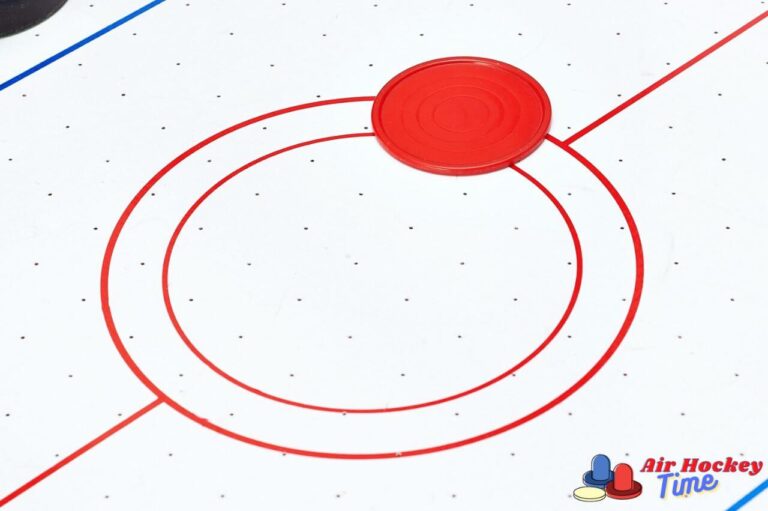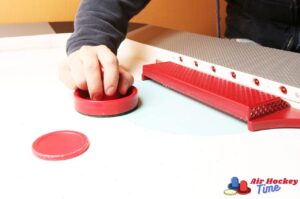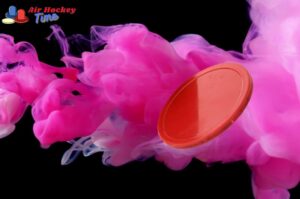When engaging in an air hockey game, one cannot help but notice the presence of circles strategically placed on the playing surface.
One of the central circles is the halfway circle, positioned at the center of the table.
The other circles, often called goal creases, serve a specific purpose in the game.
They play a significant role in shaping the gameplay and providing visual cues for players and spectators.
In this discussion, we will explore the significance of these circles in air hockey and their impact on the overall dynamics of the game.
From their practical function to their aesthetic appeal, the circles on an air hockey table contribute to an immersive and strategic experience.
So, let us delve into the world of air hockey and unravel the mysteries of the circles and their role on the playing surface.

The concept of air hockey and its rules
Air hockey is the perfect game for anyone looking to have fun while working on hand-eye coordination.
The game consists of two players using paddles to hit a plastic puck across a table sprinkled with air.
The goal is to shoot the puck into the opposing player’s goal while defending your own.
It’s fast-paced, exciting, and requires quick reflexes.
The best part? Air hockey is a great way to exercise while having a blast with your friends.
So, gather your crew, learn the rules, and get ready to experience the thrill of air hockey!
So, how do the circles on the surface help the players at the air hockey table?
The circles on the surface of an air hockey table serve as valuable visual aids that assist players during gameplay.
One of the central circles is the halfway circle, positioned at the center of the table.
This circle acts as a reference point for face-offs, determining the starting position of the puck at the beginning of each round or after a goal is scored.
It ensures a fair and balanced restart of play.
The other circles are positioned at each end of the table, these circles, also known as goal creases, provide players with a clear reference point for goal placement.
Players can better strategize their shots, improve accuracy, and enhance their overall gameplay by having a defined area to aim for.
The circles act as a guide, helping players determine the optimal position and angle to shoot the puck into the goal.
Additionally, the circles aid in defensive play by providing a visual boundary for players to guard their own goals effectively.
These markings on the surface allow players to quickly assess their positioning with the goal and adjust their movements accordingly. Ultimately, the circles on the surface of an air hockey table serve as valuable tools that assist players in their decision-making, precision, and overall performance on the table.
How can air hockey players strategize their shots better?
Air hockey players can employ several strategies to enhance their shot-making abilities and overall gameplay.
Firstly, analyzing the opponent’s weaknesses and playing style can inform shot selection.
Identifying patterns in their defense and exploiting vulnerabilities can create scoring opportunities.
Additionally, players can strategically vary their shot types, combining straight shots, bank shots, and deflections to keep the opponent off-balance.
Mastering the timing of shots is crucial, as well-timed shots can catch opponents off guard and lead to successful goals.
Controlling the puck’s speed is also essential, as slower shots can deceive opponents, while faster shots may be harder to defend.
Players should also be aware of their positioning and aim for the corners or the sides of the goal, as these areas are often more challenging for opponents to cover.
Finally, consistent practice and refining techniques through trial and error can improve shot accuracy and execution.
Combining these strategies and adapting to different game situations allows air hockey players to maximize their scoring potential and elevate their overall performance.
Tips for Controlling an Air Hockey Puck and how the circles take a role in these tips
Players can employ several tips to effectively control an air hockey puck that enhance their precision and maneuverability on the table.
Firstly, keep your eye on the puck at all times.
It may seem obvious, but it’s easy to get distracted by your opponent’s movements.
Maintaining a relaxed grip on the mallet allows for better control and flexibility in movement.
Pay attention to the angle of your mallet.
Ensure it’s at a slight angle to the table and not too high or low.
Players should use their wrists and forearm to generate controlled and accurate strikes.
Don’t be afraid to use the walls to your advantage.
Bouncing the puck off the sides can be a strategic move that catches your opponent off guard.
Additionally, positioning oneself in a balanced stance with feet shoulder-width apart provides a stable base for better puck control.
As for the role of circles, players can utilize them as reference points for puck positioning and movement.
By aligning their shots and passes with the circles, players can better gauge the trajectory and aim of their shots.
The circles also act as visual cues for defenders, helping them anticipate the puck’s path and adjust their positioning accordingly.
Players can enhance their control by using circles as guides, making precise passes, shots, and defensive maneuvers.
Consistent practice and fine-tuning these techniques while incorporating circles can improve puck control and an advantage in air hockey matches.
Frequently asked questions
Can you pass the middle line in air hockey?
In the dynamic air hockey game, specific rules govern the center line.
Passing the center line is not permitted, as players must stay on their respective sides of the table.
Each player is only allowed to hit the puck if it is located on their side of the center line.
However, an intriguing rule comes into play when the puck passes over the center line.
In such instances, the player has seven seconds to return the puck.
This rule adds an element of urgency and prevents players from engaging in long trick shots or unnecessary delays.
It ensures a fast-paced and competitive gameplay experience.
Moreover, if the puck happens to be touching the center line at any given moment, both players are granted the freedom to hit it.
This rule promotes equal opportunities and fair play, further enhancing the excitement and unpredictability of air hockey matches.
How many rounds are there in air hockey?
In the thrilling world of air hockey, the game is typically played in a series of rounds.
To determine the ultimate victor, it is common for players to compete in a best out of seven rounds format.
This means that the player who wins most of the seven rounds emerges as the winner of the game.
Each round allows players to showcase their skills, strategic prowess, and ability to outmaneuver their opponent.
The best-out-of-seven format adds an element of excitement and suspense, as the outcome of the game can shift with each round.
It also allows for comebacks and momentum swings, keeping players engaged and invested throughout the match.
Whether it’s a fierce battle between friends or professional competition, air hockey’s best seven rounds format ensures an exhilarating and competitive experience, leaving players eager to claim victory round by round.
In conclusion
The circles on an air hockey table, known as goal creases, play a vital role in the game.
These circles serve multiple purposes that contribute to the overall gameplay experience.
Firstly, they provide players with a visual reference point for goal placement, helping them strategize their shots more effectively.
The circles act as a guide, assisting players in determining the optimal position and angle to shoot the puck into the goal.
Moreover, the circles aid defensive play by offering players a visual boundary to protect their goals.
They allow players to quickly assess their positioning with the goal and adjust their movements accordingly.
The circles are valuable tools that enhance shot accuracy, precision, and overall puck control.
By utilizing the circles as guides and incorporating them into their strategies, players can elevate their performance on the table and engage in exciting, competitive air hockey matches.








